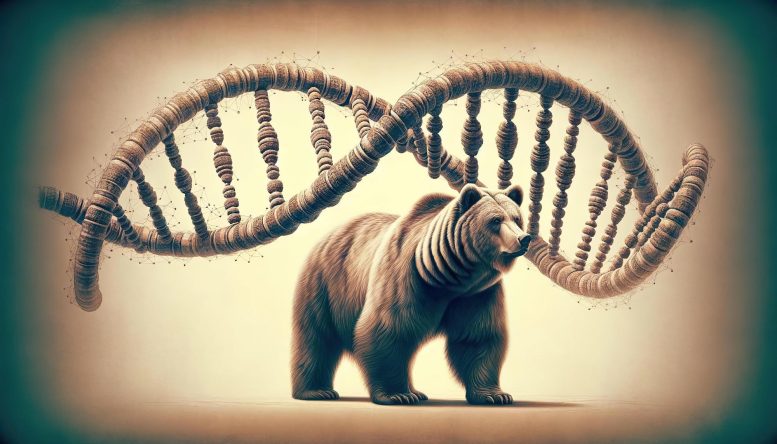How Did the Brown Bear Beat Extinction?
By
The study of ancient brown bear genomes reveals that their survival through the last Ice Age involved significant losses in range and genetic diversity, underscoring the importance of historical genetic studies in conservation efforts and future wildlife management. Credit: SciTechDaily.com
The brown bear is one of the largest terrestrial carnivores alive today, with a broad distribution throughout the Northern Hemisphere. In contrast to numerous other large carnivores that faced extinction by the end of the last Ice Age (cave bear, sabretoothed cats, cave hyena), the brown bear is one of the lucky survivors that made it through to the present. The question has puzzled biologists for close to a century – how was this so?
Brown bears are ecologically flexible and have a broad dietary range. While they are carnivores, their diets can also consist primarily of plant matter making them adaptable to environmental changes. However, brown bears also experienced extensive range reductions and regional extinctions during the last Ice Age. Brown bears used to occupy a much wider range including Ireland, Honshu, the largest island of Japan, and Quebec (Canada).
Did the decline or disappearance of bear populations in certain areas happen because bears left those places for better ones that they still currently live, or did unique groups of bears with distinct genes inhabit those areas and go extinct, leading to a loss in the overall diversity of the species?
Genetic Studies and Insights
By studying the genomes of ancient brown bears dated to between 3,800 and 60,000 years old, including several individuals from outside their current range, researchers from the University of Copenhagen, Denmark, and the University of Yamanashi, Japan sought to address this question by investigating the evolutionary relationships between brown bears across space and time.
Their study showed that brown bears did not simply move with the shifting environment, but populations went extinct. “Our analyses showed that ancient brown bears represent genetic diversity absent in today’s populations,” says Takahiro Segawa, lead author of the study. “While brown bears survived global extinction, they suffered considerable losses of their historical range and genetic diversity.” This new perspective highlights a crucial period in the brown bear’s history and that they also faced challenges during and after the last Ice Age.
“As we continue to grapple with the challenges of coexistence between humans and wildlife, insights from the deep past are invaluable in shaping a sustainable future,” adds Michael Westbury, the senior author of the study. “Although studying recent specimens can provide some insights, by including samples from the past and from areas a species no longer exists, we can better quantify how patterns of current diversity arose, and inform predictions about how they may respond to future environmental change.”
Reference: “The origins and diversification of Holarctic brown bear populations inferred from genomes of past and present populations” by Takahiro Segawa, Alba Rey-Iglesia, Eline D. Lorenzen and Michael V. Westbury, 24 January 2024, Proceedings of the Royal Society B.
DOI: 10.1098/rspb.2023.2411
By

The study of ancient brown bear genomes reveals that their survival through the last Ice Age involved significant losses in range and genetic diversity, underscoring the importance of historical genetic studies in conservation efforts and future wildlife management. Credit: SciTechDaily.com
The brown bear is one of the largest terrestrial carnivores alive today, with a broad distribution throughout the Northern Hemisphere. In contrast to numerous other large carnivores that faced extinction by the end of the last Ice Age (cave bear, sabretoothed cats, cave hyena), the brown bear is one of the lucky survivors that made it through to the present. The question has puzzled biologists for close to a century – how was this so?
Brown bears are ecologically flexible and have a broad dietary range. While they are carnivores, their diets can also consist primarily of plant matter making them adaptable to environmental changes. However, brown bears also experienced extensive range reductions and regional extinctions during the last Ice Age. Brown bears used to occupy a much wider range including Ireland, Honshu, the largest island of Japan, and Quebec (Canada).
Did the decline or disappearance of bear populations in certain areas happen because bears left those places for better ones that they still currently live, or did unique groups of bears with distinct genes inhabit those areas and go extinct, leading to a loss in the overall diversity of the species?
Genetic Studies and Insights
By studying the genomes of ancient brown bears dated to between 3,800 and 60,000 years old, including several individuals from outside their current range, researchers from the University of Copenhagen, Denmark, and the University of Yamanashi, Japan sought to address this question by investigating the evolutionary relationships between brown bears across space and time.
Their study showed that brown bears did not simply move with the shifting environment, but populations went extinct. “Our analyses showed that ancient brown bears represent genetic diversity absent in today’s populations,” says Takahiro Segawa, lead author of the study. “While brown bears survived global extinction, they suffered considerable losses of their historical range and genetic diversity.” This new perspective highlights a crucial period in the brown bear’s history and that they also faced challenges during and after the last Ice Age.
“As we continue to grapple with the challenges of coexistence between humans and wildlife, insights from the deep past are invaluable in shaping a sustainable future,” adds Michael Westbury, the senior author of the study. “Although studying recent specimens can provide some insights, by including samples from the past and from areas a species no longer exists, we can better quantify how patterns of current diversity arose, and inform predictions about how they may respond to future environmental change.”
Reference: “The origins and diversification of Holarctic brown bear populations inferred from genomes of past and present populations” by Takahiro Segawa, Alba Rey-Iglesia, Eline D. Lorenzen and Michael V. Westbury, 24 January 2024, Proceedings of the Royal Society B.
DOI: 10.1098/rspb.2023.2411
